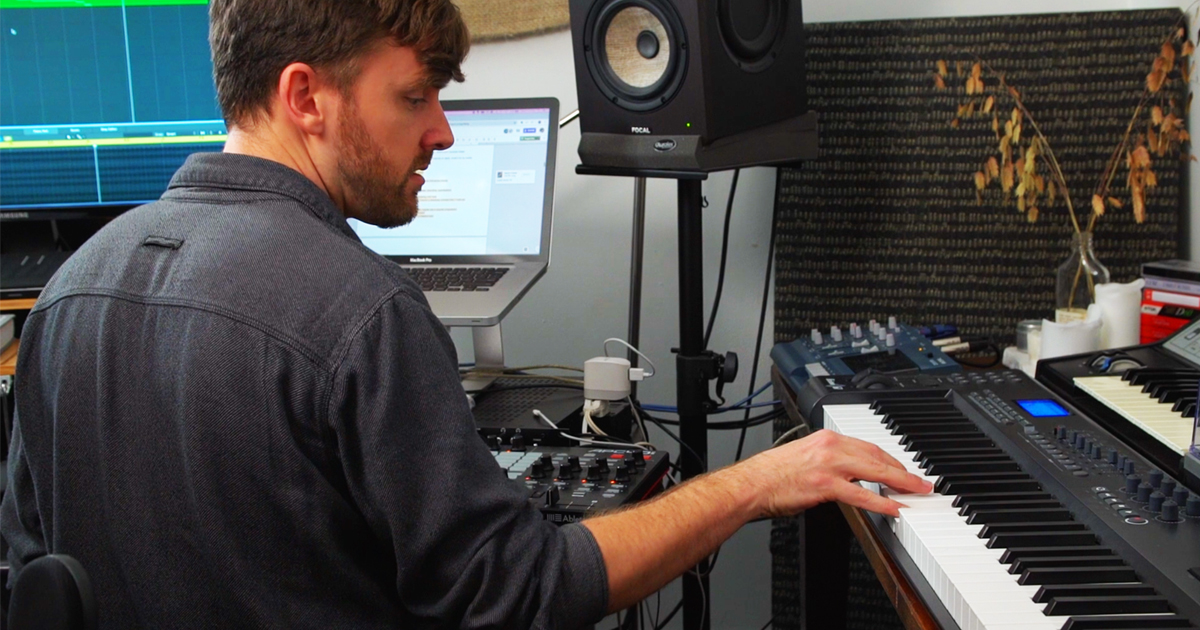
+ Improve your songwriting with Soundfly’s range of courses on emotional chord progressions, basic songwriting technique, songwriting for producers, and more.
Musical collaboration through call and response is, and has historically been, an outlet for bonding with one another through shared communication. Considered a democratic act in which more than one individual is needed to complete the participatory phrases, call and response is a form of melodic writing in which one voice or instrument directly responds to the other, completing the other’s “musical sentence.”
But what about instances when you are by yourself, and it is only you tasked with responding to each call? This requires a deeper sense of intuition and focus, because you are the sole creator of multiple voices. This may sound complicated; but we’re going to simplify it so you can get started right away.
And it can be fun, too!
Writing call and response with yourself requires tapping into different parts of yourself, extracting different moods you might be experiencing. In a way, you are finding common ground with yourself, with the end goal being both voices are equal participants and yet possess a feeling all of their own, like the perfect duet.
Here are some tips — let’s dive in!
And for you songwriting producers out there, Soundfly just launched a brand new course with Kimbra, in which she herself demystifies her variety of vocal techniques and creative sources of inspiration, including her philosophy on developing different vocal characters. Go check out this in-depth new course, Kimbra: Vocal Creativity, Arranging, and Production.
1. Simplicity Is Key
It is tempting to think that the most beautiful music is the most complicated. And sure, while timeless music such as Vivaldi’s “Four Seasons” may indeed be elaborate, even complex, composers typically use foundational patterns and emphasize themes and variations in the structure of their music to utilize the strengths of familiarity.
Something simple, a short melodic phrase, repeated, will always bring your listener’s ear back to a sense of home, comfort, and resolution. You can complicate whatever you want, as long as you come back to something simple when it matters most (ie: your chorus or hook is a great place to start!).
It may sound like heavy metal guitarists such as Yngwie Malmsteen and Randy Rhodes are just playing a lot of notes while soloing, but they almost always return to the notes of their scale in simple patterns (albeit lightning fast).
2. Don’t Underestimate the Power of a Root Note!
In the road map of your composition, if you feel your melody getting lost a bit you can always return to the root (the first note in your scale); especially if in your call and response setup, one of the voices leads the other to the root.
Alternatively, some of the most memorable melodies are the ones where one voice simply rides the root note while the other voice continues the more intricate melody. Being able to focus on, and return to, the same note no matter what octave you are playing in, opens up vast creative compositional potential.
+ Learn production, composition, songwriting, theory, arranging, mixing, and more — whenever you want and wherever you are. Subscribe for unlimited access!
3. Listen to Music With Consonant Voices
Whether it’s pop or classical music, consonant voicings of melodies and chords help the piece glue together. But this isn’t always what you want. In rock for example, when the bass guitar follows the rhythm guitar along in the progression, it can be tough to even tell them apart sonically.
So one way to make a consonant melody truly stand out is to have either your instruments or voices play the same pitches, but rearranged in different patterns, in what’s often called counterpoint.
Whether you write your notes in a syncopated rhythmic phrase, or in an alternating melodic phrase where one voice is going down in the scale while the other goes up, for example, this will help showcase the overall relationship between the two. Counterpoint voices harmonize with one another while functioning independently of each other in terms of duration and melody.
A famous example of this is “Bourée in E Minor” by JS Bach. Originally composed on the lute, the treble voice ventures up the scale while the bass voice goes down. The two consonant voices create a buffer for one another which “fill out” or widen the sound of the music. Though the two melodies are different, they compliment one another to create one of the most memorable musical passages ever written.
4. Improvise, Record, and Loop
Easy access to recording gear and loop stations makes building melodies with yourself so much more convenient.
Record one musical voice first. Loop it and continue to experiment with a second musical voice over top of it. Don’t shy away from improvisation, and don’t worry about perfection. Look for really cool sounding synergies and harmonies between the two voices. And have fun with it; when you’re in a groove and just jamming with yourself, the best ideas eventually float to the surface.
I always like improvising for longer periods of time because I can then go back over my work and look for parts that sounded good in the moment; later, I’ll build melodies based on those improvised phrases. Don’t be afraid to make mistakes in your spontaneous composition! Remember, the best creativity often comes from a willingness to relinquish perfectionism.
+ Read more on Flypaper: “4 Ways to Develop Your Musical Idea Into a Full Arrangement.”
5. Experiment With Different Octaves
While trying to compose different melodies in the same octave, you may run into the issue of your music sounding muddy and not blending together. Try separating the octaves to serve different functions in your arrangement; it will help the melodies spread out and you can call one or respond to the other across a wider range.
Venture out of your vocal comfort zone and look to harmonize with your first voice. If one voice uses more quarter notes, focus on half or whole notes with the other so as not to overpower the original voice. Remember that for call and response to be effective, the two voices must play off one another, not compete with one another.
The best call and response melodies are the ones in which the fluidity of the melody always draws back to a level of simple structure and foundation. Structure creates more room for spontaneity, so you can leave room for improvisation to lead to innovation.
The greatest thing about writing call and response melodies with yourself is discovering how many musical voices you have inside of yourself, and tapping into different sides of yourself that you might not have even known were there!
Continue learning with hundreds of lessons on songwriting, composing, home recording, electronic production, beat making, and much more. Explore Soundfly’s exciting courses like Modern Pop Vocal Production, Unlocking the Emotional Power of Chords, and Kimbra: Vocal Creativity, Arranging, and Production.





